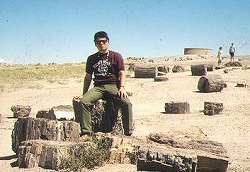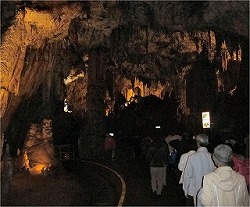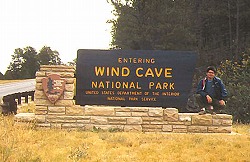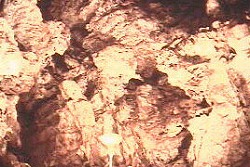We were busy on the second day too.
Emiko joined the walking around Kasayama-myojin Pond from 8:30 am, but
I didn't. I took a rest in the toilet reading the today's paper and in
the room watching TV.
During the morning, visit to the Hagi pottery and the town of Hagi Castle.
Then the optional tours. Emiko joined the visit to "Misuzu Kaneko
Memorial Hall." I chose getting on the "Sightseeing Cruiser around
Aomijima Island."
Cruising around Aomijima and Ohshima Islands
 It is always and everywhere pleasant to cruise by a small boat. All the same here around Senzaki, Nagato City. It is always and everywhere pleasant to cruise by a small boat. All the same here around Senzaki, Nagato City.
A variety of small islands and rocks appeared over the sea spray, with
seagulls running after. Surf-fishing people were seen on rock shores with
eagles and hawks aiming at fishes in the sky.
The scenes before my eyes were changing one after another at a dizzying
pace.
The one-hour cruising was so thrilling that I felt the powerful nature
all the way.
What was Emiko doing during the time?
She was really enjoying the Memorial Museum of Misuzu Kaneko.
Her haiku poems proves it. (Sorry, no translation.)
| Misuzu kan tatami atataka kutsu nugite |
|
| Gakudo no koe no afurete suzume no su |
|
| Haru tomoshi tsukue ni shishu hirakarete |
Akiyoshidai Quasi-National Park
After lunch, we visited the Akiyoshi Plateau (Akiyoshi-dai) and Akiyoshido
Cave(Akiyoshi-do) in Mine City, Yamaguchi Pref. They were the panorama
on and under the ground.
The Akiyoshi Plateau is the largest-scale karst topography of 130 square-kilometer
area in Japan.
According to Wikipedia,
| The plateau consists of uplifted reef limestones of Paleozoic age, which
were thickened by overfolding during the Akiyoshidai orogenic movement.
Subsequent erosion has created an undulating karst landscape dimpled with
many dolines and countless limestone pinnacles up to two meters in height.
Beneath the surface lie hundreds of caves, a few of them quite significant
geologically. Numerous fossils of Pleistocene age have been found in these
caves, including those of the Japanese rhinoceros, Stegodont elephant,
Naumann elephant, Young tiger, and numerous other animals from the last
interglacial period. |
Besides such a specialty, a magnificent landscape was widened before us.
Around 40 years ago, while I traveled across the United States with 2 friends
riding an old Mustang, I was astonished to see the view of Petrified Forest
in Arizona State. It was a desert where the petrified trunks of the old
forest lay scattered on the sand like the ruins of an ancient marble temple.
The ranger gave me a small fossil as a souvenir. It is now on my desk.
I happened to remember those old days.
 |
| Akiyoshi Plateau |
 |
|
 |
|
 |
| Petrified Forest in 1969 |
|
|
Only a stone's throw from Akiyoshi Plateau was Akiyoshido Cave. According
to Wikipedia,
| This spacious cave is up to 100 meters wide and has 8.79 kilometers of passages, making it the longest in Japan and one of the longest in Asia. At the present time an about one-kilometer-long section of the cave is open to the public as a sightseeing course, with a walkway and bridge system, entering at the cave's lowest point and exiting via an artificial elevator. This portion of the cave is also well decorated with a variety of large and colorful speleothems. |
We walked on the sightseeing route for about 1 km.
"100 Pieces of Plates" like terraced fields, the stalactite called
"Gold Column" of 15 meters high, "Umbrellas", ......
I had to prostrate myself, looking at each view and thinking the everlasting
work of nature.
When our couple traveled around four countries of Central Europe 3 years
ago in 2009, we visited Postojna Cave, Slovenia. My memory is clear still
now that I was astonished to see its extraordinary magnificence.
The scale, the depth, and what not. It must be thoughtless to compare what
we are in now with Postojna Cave about everything. However, the cave here
was worthwhile to be honest and I enjoyed it for sure.
During the driving travel across the US 40 years ago as I mentioned above,
we visited Wind Cave in South Dakota. The faint memory there happened to
come out to me. It was also a National Park of the US.
I don't know why, but I did not have such deep emotion at that time.
 |
| Postojna Cave ↑ |
|
 |
| Wind Cave, 1969 ↑↓ |
 |
Other Pictures at Akiyoshido Cave
|